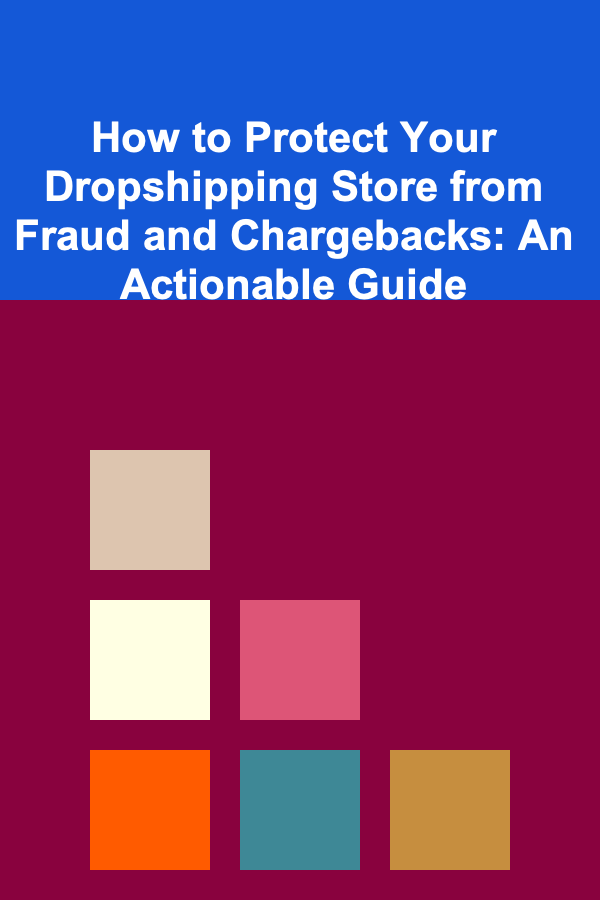
How to Protect Your Dropshipping Store from Fraud and Chargebacks: An Actionable Guide
ebook include PDF & Audio bundle (Micro Guide)
$12.99$9.99
Limited Time Offer! Order within the next:

Running a dropshipping store comes with its fair share of challenges, but one of the most significant risks that online retailers face is fraud and chargebacks. Fraudulent transactions and chargebacks can be costly, both financially and reputationally, and they can take a huge toll on your business. The best way to mitigate these risks is by proactively implementing strategies that protect your store from fraud and reduce the likelihood of chargebacks.
In this actionable guide, we'll explore the most effective steps you can take to protect your dropshipping store from fraud and chargebacks, covering everything from identifying fraudulent behavior to using the right tools to mitigate risks.
Understand the Risks: Why Fraud and Chargebacks Matter
Before we dive into the strategies, it's essential to understand why fraud and chargebacks pose a risk to your dropshipping business.
A. Fraud Risks
Fraud in eCommerce involves any deceptive attempt to gain something of value, such as products or services, through illegal means. For dropshipping stores, the most common types of fraud include:
- Credit Card Fraud: The use of stolen or fake credit card information to make purchases.
- Account Takeover: When fraudsters gain access to a legitimate customer's account and make unauthorized purchases.
- Friendly Fraud: A situation where legitimate customers make a purchase, receive the product, and then dispute the charge with their bank, claiming they didn't make the purchase.
B. Chargeback Risks
Chargebacks occur when a customer disputes a transaction, and the bank reverses the payment. Chargebacks are particularly problematic because they not only result in the loss of revenue but can also lead to additional penalties, including higher transaction fees and even the suspension of your payment processor if chargeback rates exceed certain thresholds.
For dropshippers, high chargeback rates are a red flag to payment processors, which can result in the termination of your account, impacting your ability to receive payments.
Strategies to Prevent Fraud in Your Dropshipping Store
A. Use a Secure Payment Gateway
The first line of defense against fraud is choosing a secure, reliable payment gateway. Look for payment processors that provide advanced fraud detection features such as:
- 3D Secure (3DS): An added layer of authentication for credit card payments. It requires customers to confirm their identity through a one-time password (OTP) or biometric scan, reducing the risk of unauthorized transactions.
- Fraud Detection Algorithms: Some payment gateways offer real-time fraud monitoring, analyzing transaction patterns to flag suspicious activity. For example, Shopify Payments, Stripe, and PayPal all have built-in fraud protection.
- Tokenization: This technology replaces sensitive payment information with a randomly generated token, reducing the likelihood of credit card fraud.
Always ensure your payment gateway supports secure transactions and is compliant with the latest standards, such as the Payment Card Industry Data Security Standard (PCI DSS).
B. Set Up Strong Customer Authentication
One of the best ways to protect your store from fraudulent orders is by implementing strong customer authentication practices. A few key methods include:
- Email Verification: Require customers to verify their email addresses before completing their orders. This ensures that the person making the purchase is who they claim to be.
- Phone Number Validation: Use tools to validate phone numbers to avoid fraudulent orders using fake or non-existent numbers.
- Address Verification System (AVS): Many payment processors and gateways have AVS, which compares the billing address entered by the customer to the one on file with the credit card issuer. If the addresses don't match, the transaction can be flagged for review.
C. Monitor Suspicious Activity
Be proactive in identifying potentially fraudulent activity on your store. This can include:
- Unusually Large Orders: Multiple high-value items ordered from a single customer or multiple orders made within a short period.
- Frequent Changes to Billing or Shipping Information: A customer who frequently changes their payment method, address, or other information may be attempting to avoid detection.
- Foreign Orders: Orders placed from high-risk countries with a known history of fraud should be flagged for further review.
You can use anti-fraud tools and plugins (e.g., Signifyd, Sift, or FraudLabs Pro) to monitor transactions and identify unusual patterns.
D. Utilize Machine Learning and AI Tools
AI-powered fraud detection tools can analyze thousands of data points in real time, identifying patterns of fraudulent activity that might be missed by manual checks. These tools learn from past data and adjust their algorithms to better detect suspicious transactions over time.
Many dropshipping platforms, including Shopify and WooCommerce, offer integrations with machine learning tools that help protect against fraud and ensure a secure checkout process.
Strategies to Prevent Chargebacks in Your Dropshipping Store
A. Clear and Transparent Store Policies
One of the most effective ways to prevent chargebacks is to establish clear, transparent policies regarding shipping, returns, and refunds. Make sure your customers understand the terms and conditions of their purchase before they place an order.
- Shipping Policies: Be clear about delivery times, shipping fees, and the countries you ship to. Make sure customers are aware of potential delays, especially if you're dropshipping from international suppliers.
- Refund and Return Policies: Have a clear return and refund policy that's easy to find on your website. Ensure that customers know they can't initiate a chargeback if they can simply return the product for a refund.
- Dispute Resolution Process: Make it easy for customers to contact you if there's an issue with their order. This can reduce the likelihood of a chargeback, as customers are more likely to work with you directly rather than disputing the charge with their bank.
B. Provide Clear Billing Descriptions
Ensure your billing descriptor (the name that appears on the customer's credit card statement) is easily recognizable. If your store's name or the name of your payment processor is confusing or unidentifiable, customers might not remember the charge, leading to a dispute.
Your billing descriptor should reflect a name that's consistent with your business name or an easily identifiable acronym.
C. Request Customer Verification for High-Risk Orders
For high-ticket items or suspicious orders, consider manually verifying the customer before processing the payment. This verification process might involve:
- Contacting the Customer Directly: Call or email the customer to verify their order and confirm that they are indeed the person who placed the order.
- Requesting Proof of Identity: For large or international orders, ask the customer to send additional verification, such as a photo of their ID or a utility bill, to confirm their identity.
By taking extra steps to verify orders, you can reduce the chances of fraudulent chargebacks.
D. Track Shipments and Provide Proof of Delivery
Providing proof of delivery can be a game-changer when contesting chargebacks. Make sure to use a shipping carrier that provides tracking information and delivery confirmation.
Once the order is delivered, request that the customer acknowledges receipt via email or on your website, especially for higher-value items. This can serve as solid evidence if a customer later tries to dispute the charge.
E. Use a Chargeback Management Service
If your chargeback rate becomes a problem, you may want to invest in a chargeback management service. These services monitor chargebacks, handle the dispute process, and help you implement strategies to reduce future chargebacks. Some chargeback management services, like Chargeback Gurus or Midigator, offer detailed analytics that can help you identify the root cause of chargebacks and take corrective action.
Regularly Review Your Risk Management Practices
Fraud and chargeback prevention are ongoing processes that require regular attention. Set aside time each month or quarter to review your fraud prevention policies, evaluate your current tools and strategies, and stay informed about the latest fraud trends.
- Update Software: Keep your fraud detection tools, payment processors, and eCommerce platform up to date with the latest security patches.
- Review Payment Gateway Policies: Ensure that your payment processor is continually updating their fraud detection systems and staying compliant with security standards.
Conclusion
Fraud and chargebacks are two of the most significant risks that dropshipping store owners face, but with the right tools, strategies, and vigilance, you can minimize these risks and protect your business. By implementing strong customer authentication methods, using secure payment gateways, monitoring suspicious activity, and providing clear policies, you can significantly reduce the chances of falling victim to fraud and chargebacks.
Ultimately, taking proactive measures to safeguard your dropshipping store will not only protect your revenue but also help you build a trustworthy relationship with your customers, ensuring the long-term success of your business.
Reading More From Our Other Websites
- [Home Budget Decorating 101] How to Use Wallpaper to Transform a Room on a Budget
- [Organization Tip 101] How to Use Color Coding for Your DIY Supplies
- [Home Renovating 101] How to Add Curb Appeal on a Shoestring Budget
- [Home Lighting 101] How to Use Smart Lighting to Enhance Your Home's Style
- [Organization Tip 101] How to Manage Business Documents as a Solopreneur
- [Organization Tip 101] How to Create a Seasonal Checklist for Home Maintenance
- [Home Pet Care 101] How to Protect Your Furniture and Floors from Pet Damage
- [Beachcombing Tip 101] Gear Guide: Must-Have Tools and Gadgets for Serious Beachcombers
- [Home Rental Property 101] How to Design an Inviting Outdoor Living Space on Your Rental's Private Deck
- [Personal Care Tips 101] How to Remove Waterproof Mascara Effectively
How to Create a Personal Finance Dashboard for Better Tracking
Read More
How to Save Space in Your Home Using Multi-Purpose Storage Solutions
Read More
Why Organizing Your Garage Can Free Up Space Indoors
Read More
How To Use Flashcards for Language Learning
Read More
Learning to Tune Your Instrument by Ear: A Comprehensive Guide
Read More
10 Tips for a Pottery Glazing Checklist
Read MoreOther Products
How to Create a Personal Finance Dashboard for Better Tracking
Read More
How to Save Space in Your Home Using Multi-Purpose Storage Solutions
Read More
Why Organizing Your Garage Can Free Up Space Indoors
Read More
How To Use Flashcards for Language Learning
Read More
Learning to Tune Your Instrument by Ear: A Comprehensive Guide
Read More